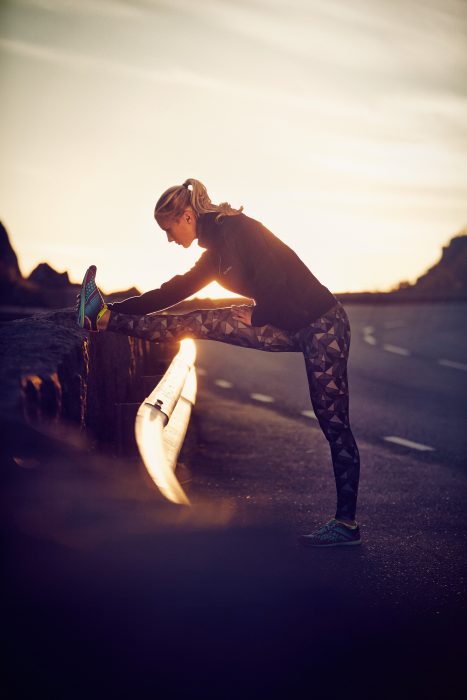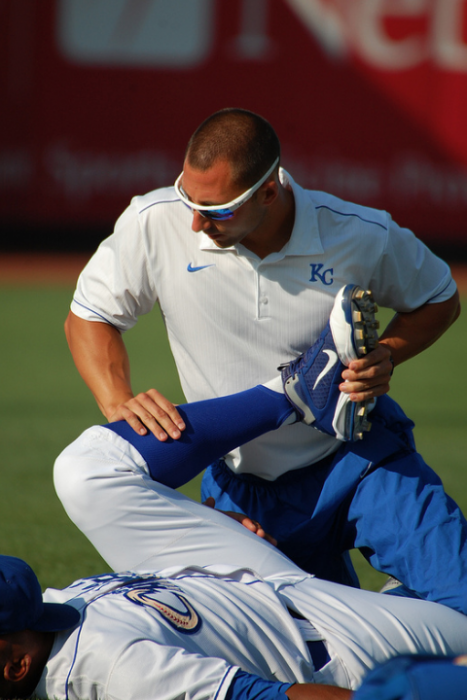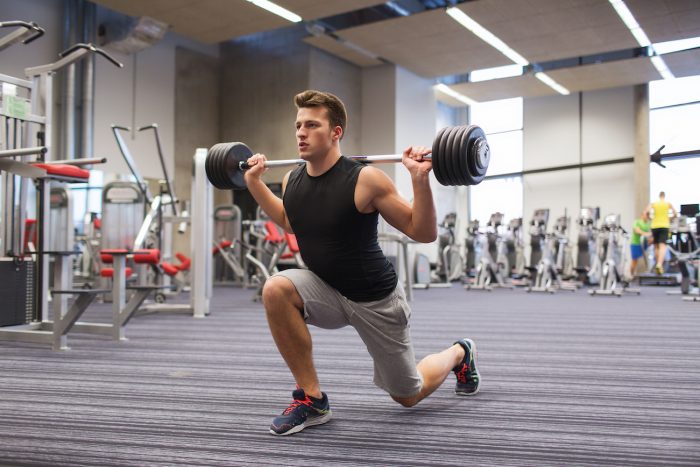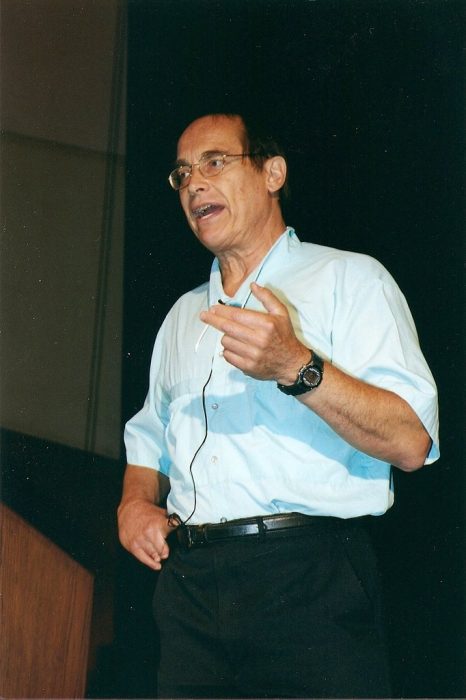When most people think ‘Flexibility’, they think ‘Stretching’. The idea that making the muscles ‘longer and looser’ is an essential part of warming-up, cooling down, and enhancing performance for a sport such as squash is one of those ideas that is pretty entrenched in most players mind.
There is rather more to the topic however, and in this 2 part article we’ll take a look at the truth behind the generally accepted wisdom of the benefits of flexibility training and the different types of ‘stretching’, and see how it all relates back to the squash player.
In part 1 of this article, we looked at the role of stretching where it has found perhaps its most traditional place – as part of the warm-up. Despite the long-standing pre-exercise institution of the standard 20-30 sec ‘static stretch’ held for each muscle group, research has shown this has no appreciable benefit to subsequent performance or injury prevention, and in fact some studies have even suggested that it may actually INCREASE injury risk and REDUCE performance.
More and more trainers and coaches are finally starting to take these findings on board, and we’re seeing a shift toward more progressive dynamic, functional warm-ups for the most part. In part 2 of this article, we’re looking at flexibility as part of a wider training programme, and exploring the mechanics of what actually happens when we statically ‘stretch’ a muscle.
‘Flexibility’ then, is defined simply as the range of movement around a joint. This range of motion isn’t determined just by the muscles, but by our skin, bones, ligaments, tendons, and fascia – important components that go into making up the general stability of a joint.
Inside the human body doesn’t really look much like those nice brightly coloured anatomical muscle charts with everything clean and clearly defined and separated, there is a lot of other soft tissue contained in and around the muscles that has to be factored in as well when considering the effects of stretching. So while the muscles themselves do have a certain amount of elasticity in their structure (usually estimated at around an additional 10% of their resting length), this isn’t necessarily the case with the other components of a standard human joint – ligaments/tendons etc will start to tear when taken further than 3-5% beyond their resting length and will break when taken to around 10%, while bones obviously can’t stretch at all.

So, we need to consider what’s actually happening when most people think they’re ‘stretching’ – if you’re not isolating the muscle when attempting to stretch a joint due to the surrounding bones/soft tissue (which don’t contain anywhere near the natural elasticity of a muscle, and you really don’t want to be placing any significant force upon in any case), how effective can stretching be in terms of the generally accepted belief that you’re actually somehow ‘elongating’ the targeted area to any significant degree?
Even in areas where we can target the actual muscle directly through properly adjusted technically correct stretching exercises of appropriate force/direction/time, to actually take a muscle beyond just the elastic limit and achieve some level of actual ‘plastic deformation’ or measurable change in length at a structural level (without tearing and injuring the muscle), requires a lot more force and stretching than most people ever put in.
Indeed, some research suggests holding a static stretch for anything between 10 and 20mins is necessary to actually achieve any true mechanical lengthening of any significance, and even this additional ‘length’ will quickly be lost if the stretch is performed on just an occasional or infrequent basis. So when most people think they’re actually physically ‘stretching’ a muscle when putting a joint through a typical brief flexed/extended position, they’re often not really doing anything of the sort.
There is evidence to suggest however, that repeating a consistent and dedicated daily stretching programme with properly focused technique over a longer period of time, can eventually show some amount of physical lengthening in certain muscles. A muscle may get incrementally ‘longer’ with such a properly structured stretching programme, though not ‘less stiff’ as some people wrongly presume. In a normal healthy and hydrated muscle, flexibility is inhibited by its length (or lack of) not by any ‘stiffness’ or material resistance to stretch.
 Excessively flexible individuals such as gymnasts and contortionists of course, certainly seem to demonstrate some of this physical change in their muscle length and looseness. A lot of this tends to be developed when they are younger however (when muscles and joints are more pliable and susceptible to change), and is often achieved with rather extreme methods – particularly in countries where child welfare is somewhat less of a consideration; see here for some rather unpleasant examples.
Excessively flexible individuals such as gymnasts and contortionists of course, certainly seem to demonstrate some of this physical change in their muscle length and looseness. A lot of this tends to be developed when they are younger however (when muscles and joints are more pliable and susceptible to change), and is often achieved with rather extreme methods – particularly in countries where child welfare is somewhat less of a consideration; see here for some rather unpleasant examples.
All that in mind, when most people have even a quick stretch for a typical area like the thigh or hamstring however, they still typically report an obvious ‘feel’ of a greater range of motion. This sensation is one that most people would be familiar with, so what exactly is going on here then?
The theory that has gained increasing traction within the scientific literature is that in most cases we are not actually lengthening the muscle as we might believe, but increasing our tolerance to the stretch. By holding and gradually pushing a standard static stretch, we are actually only working to slowly override our body’s pain threshold and natural protective mechanisms and proprioceptors that act to prevent our muscles being taken beyond their ‘safe’ range of motion, and this can result in quite a significant effect. So we may be noticeably increasing our observable range of motion, but not through any actual mechanical change in structure.
So a quick stretch may feel good in the same way scratching an itch might, but it could be argued that prolonged stretching over time that gradually overcomes the body’s protective mechanisms is perhaps not really a good thing – the body has these stretch reflex protective mechanisms for a reason. It’s theorised that there is at least some element of this ‘stretch tolerance’ even in the aforementioned long-term trained highly flexible gymnasts (and other particularly bendy people such as yoga practitioners).
So what does all this mean in the context of flexibility training as part of our squash conditioning programme?
Firstly, we need to consider why we’re actually incorporating any kind of stretching. Some people stretch as they believe it helps relieve knots or eases trigger points within the muscle, though research suggests any physical benefit that might be felt from this will only be very temporary. Others stretch post-session as they feel it will help with recovery and any DOMS (muscle soreness) the next day. The cool-down (or warm-down) concept is a subject we’ve looked at before, and the static stretching element in particular has been shown to be an essentially ineffective part of this beyond just a mild placebo effect.
If instead we’re stretching just because we feel like we have to due to accepted wisdom, or because there’s a belief that it somehow helps increase our resistance to injury, then this can also probably fairly safely be disregarded. Most muscle/tendon/ligament injuries in squash are due to sudden overload or unnatural force being placed upon them, and there is little evidence that regularly stretching otherwise healthy muscles has any real effect on injury rates – indeed, too much flexibility around a joint can itself possibly lead to problems of instability and joint laxity. Properly warming the body up through graduated progressive multi-directional movements and sport-specific activities, is going to have way more of an effect on the likelihood of injury than any small difference in the length of our muscles (assuming even that we have developed some structural lengthening and not just a tolerance to static stretch).

That said, if there is an actual discrepancy or imbalance in the muscles surrounding a joint (either through lifestyle factors or due to previous injury) and this is causing a limited or restricted range of motion, then this could provide a potential increased susceptibility to injury and would of course need to be addressed. You may feel restricted in certain positions or movements, and a properly trained physiotherapist or strength & conditioning coach may be able to further identify and confirm limitations in the functional range of motion through a joint, using various drills/exercises or movement screens that highlight these restrictions.
It’s important to remember here that optimal ranges of motion around joints are going to be different for different athletes – the flexibility required around the hips for a gymnast is going to be very different to that of a cyclist, which is going to be very different to that of a squash player, so there is no universally ‘ideal’ range of motion in a joint, just suggested ranges depending on the biomechanics of the sport in question. A squash player obviously needs to be able to perform a lunge of reasonable depth for example, so if the muscles around the hip do not allow this then this would need to be addressed.
But if generalised static stretching is not really the best way to ‘lengthen’ and solve these joint/muscle issues, how do we go about developing this ideal range of motion necessary for optimal performance?
This is where the expert input of a trained professional would ideally come in, to prescribe a proper programme of targeted flexibility work for performance (or as part of a rehab programme from injury), or by researching yourself what the best flexibility routines are for your specific sport or circumstances. This may possibly still incorporate some variations of static stretches for some individuals with specific problems, but will likely predominantly consist of dynamic flexibility/active mobility drills, and other more advanced stretching methods such as proprioceptive neuromuscular facilitation (PNF) techniques, foam roller work, and multi-planar strengthening exercises.
This element of ‘strength’ is a very important one to consider here, as any increase in flexibility ideally needs to be reciprocated with proper strengthening – a yoga practitioner may have great hip flexibility from years of continual stretching routines that allows them to drop into the perfect splits position for example, but do they have the same dynamic strength from that position to be able to explosively push up and spring back to a standing position in the same way someone like Greg Gaultier does on the squash court?
 Flexibility without equivalent strength is of little use in an athletic sense, and this is another benefit of incorporating proper resistance training into your programme – It’s a huge myth that training with weights REDUCES flexibility; deep squat, lunge, and deadlift variants will develop strength AND mobility around a joint if properly performed. If you can deep squat a load equal to your bodyweight with perfect form through a full range of motion (thighs below parallel) as an example, then lower body functional mobility is unlikely to be a significant issue for you.
Flexibility without equivalent strength is of little use in an athletic sense, and this is another benefit of incorporating proper resistance training into your programme – It’s a huge myth that training with weights REDUCES flexibility; deep squat, lunge, and deadlift variants will develop strength AND mobility around a joint if properly performed. If you can deep squat a load equal to your bodyweight with perfect form through a full range of motion (thighs below parallel) as an example, then lower body functional mobility is unlikely to be a significant issue for you.
Lower body functional mobility unfortunately IS an issue for many people in modern life however, with certain muscles adaptively shortened, and others pulled, weakened, disengaged, or just not properly firing.

Sitting slouched at a PC all day, or spending daily long journeys sat at the wheel of a car, can potentially cause all manner of problems and inhibitions within our muscles and joints. Getting into good habits of getting up from your desk and walking around every 15mins, or making regularly scheduled stops on any frequent long car journeys and using things like lumbar supports, can help to avoid any joint imbalance issues occurring in the first place. Getting into the habit of regular squash-specific (or any other activity-specific) active range of motion work incorporated into your warm-up or daily exercise routine will be of real benefit, with properly targeted mobilisation and strengthening work potentially helping avoid these issues and the need to seek professional intervention. Of course for squash players, you have the benefit of all the videos and articles here on SquashSkills to help point you in the right direction!
There is still no one blanket recommendation for flexibility, though most experts currently take the approach of working to develop and maintain a functional range of motion specific to each person, each joint, and the sport that you play, through the use of dynamic flexibility drills and functional range of motion exercises specific to the movements you most commonly undertake. So for squash simulating lunging, twisting, turning, and other dynamic movements around the hip, knee, ankle, and shoulder (as seen in our videos), of an active not static nature, will be of greatest benefit.
If you have particular restrictions around a joint that affect your play/movement, seek guidance from a therapist who can help intervene with any imbalances and inhibitions, don’t just randomly sit and stretch different things in the hope it might go away. There is some evidence that implements such as foam rollers, trigger-point balls, and massage sticks can also be beneficial here. Again, like many things though, there is always likely to be some element of individual variance in effectiveness.
Flexibility/stretching is a topic that contains large amounts of varying opinions, conflicting views, and contrasting research. There is still a lot of work that needs to be done to draw more concrete conclusions about the role and effects of stretching, but certainly a clearer picture is beginning to emerge of the anatomy of stretching and the limitations of many of our previous assumptions. New research is constantly being reviewed, adjusted, and interpreted, and due to the inherent multi-faceted nature of the topic there will likely never be any kind of definitive consensus that’s fits all people in all situations.
A lot of people of course, just like the ‘feel’ of a good stretch. So if standard static stretching makes you feel better, then by all means do it for that reason – it’s unlikely realistically to do any kind of real harm. The most up to date recommendations however, are moving in the direction that there are far better ways to optimise your flexibility (and time) than sitting and holding various batteries of single-dimensional linear static stretches. There is scant evidence indicating that any small amount of increased flexibility gained in this way has any correlation with either injury prevention or increased performance, in the same way that increasing speed, agility, strength, power etc would have.
 A good place to finish this article is with a passage that provides a neat summary of this ‘alternate’ view and challenge to the established dogma of traditional stretching, which perhaps isn’t as new and radical an idea as many believe. The passage is from Dr Mel Siff, one of the foremost authorities and pioneers in the field of physical training in the past 20yrs, written before his untimely death back in 2003:
A good place to finish this article is with a passage that provides a neat summary of this ‘alternate’ view and challenge to the established dogma of traditional stretching, which perhaps isn’t as new and radical an idea as many believe. The passage is from Dr Mel Siff, one of the foremost authorities and pioneers in the field of physical training in the past 20yrs, written before his untimely death back in 2003:
“It is almost heretical to question this stretching doctrine, yet it is important to disclose that there is no research which proves categorically that there is any need for separate stretching sessions, phases or exercises to be conducted to improve performance and safety. To appreciate this fact, it is useful to return to one of the clinical definitions of flexibility, namely that flexibility refers to the range of movement of a specific joint or group of anatomical tissues. Moreover, flexibility cannot be considered separate from other fitness factors such as strength and stamina. There is no real need to prescribe separate stretching exercises or sessions, since logically structured training should take every joint progressively through its full range of static and dynamic movement. In other words every movement should be performed to enhance flexibility, strength, speed, local muscular endurance and skill, so that separate stretching sessions then become largely redundant”
MEL SIFF
For those looking for more info on the current research as regards stretching, a good place to start is with strengthandconditioningresearch.com and their dedicated stretch feature here.
Gary Nisbet
B.Sc.(Hons), CSCS, NSCA-CPT, Dip. FTST
Squashskills Fitness & Performance Director
Sign up to the SquashSkills newsletter
Get world class coaching tips, straight to your inbox!